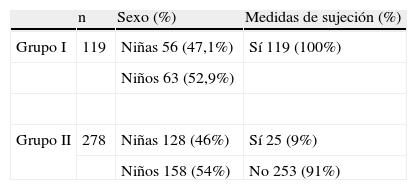Conocer el comportamiento de un nuevo modelo de termómetro de infrarrojos de cono más pequeño y valorar si es una alternativa adecuada para la determinación de la fiebre en niños menores de 14 años.
MétodoEstudio descriptivo transversal que compara las temperaturas tomadas con termómetro de mercurio y termómetro de infrarrojos en menores de 14 años. Las investigadoras siguieron las instrucciones de uso de cada termómetro. En una muestra de 400 niños se hicieron 2 grupos de edad: grupo I, menores de 2 años, y grupo II, desde los 2 hasta los 14 años. Para el grupo I se utilizó el termómetro de mercurio rectal durante 3min en recto y el termómetro timpánico en modo rectal en oído derecho. Para el grupo II el termómetro de mercurio axilar durante 8min en axila derecha y termómetro timpánico en modo axilar. Para analizar el sesgo intraobservador, se seleccionaron 50 pacientes de la muestra a los que 2 enfermeras del equipo tomaron las temperaturas de forma simultánea. Tanto para medir la fiabilidad del termómetro timpánico como para analizar el sesgo intraobservador se utilizó el coeficiente de correlación intraclase (CCI).
ResultadosEl acuerdo entre las mediciones de temperatura con ambos instrumentos se ha medido por el CCI. Para el grupo I se obtuvo un CCI=0,91 (intervalo de confianza [IC] del 95%, 0,88–0,94) y para el grupo II un CCI=0,90 (IC del 95%, 0,87–0,92).
La reproducibilidad de las mediciones realizadas por 2 enfermeras en 50 pacientes ha mostrado para el termómetro timpánico un CCI=0,97 (IC del 95%, 0,95–0,98).
ConclusionesEl termómetro de infrarrojos es un dispositivo adecuado de valoración rápida de temperatura en nuestra área de trabajo de urgencias. Pero se deben confirmar las temperaturas con otro método cuando implique decisiones clínicas.
To determine the behavior of a new and smaller model of infrared thermometer cone and to assess whether it is an appropriate alternative to determine fever in children under 14 years old.
MethodWe performed a cross-sectional, descriptive study comparing the temperatures taken with a mercury thermometer with those taken by an infrared thermometer in children under 14 years old. The researchers followed the manufacturer's instructions for use for each thermometer. The overall sample of 400 children was divided into two age groups. Group I consisted of children aged less than 2 years and group II of 2–14-years-old. In group I the rectal mercury thermometer was placed in the rectum for 3minutes and the tympanic thermometer was used in rectal mode and placed in the right ear.
In group II, the axillary mercury thermometer was placed for 8minutes in the right axilla and the tympanic thermometer was used in the axillary mode. To analyze intraobserver bias, 50 patients were selected from the sample and their temperatures were simultaneously taken by two nurses from the team. The intraclass correlation coefficient (ICC) was used both to measure the reliability of the tympanic thermometer and to analyze intraobserver bias.
ResultsTemperature measurements with both instruments showed an ICC of 0.91 (95% confidence interval [CI], 0.88–0.94) for group I and 0.90 (95%CI, 0.87–0.92) for group II. The reproducibility of the measurements taken by the two nurses in 50 patients showed an ICC of 0.97 (95%CI, 0.95–0.98) for the tympanic thermometer.
ConclusionsThe infrared thermometer is an appropriate device for rapidly measuring temperature in the emergency department. However, the measurements taken should be confirmed by another method when clinical decisions are based on temperature values.
Artículo
Comprando el artículo el PDF del mismo podrá ser descargado
Precio 19,34 €
Comprar ahora










